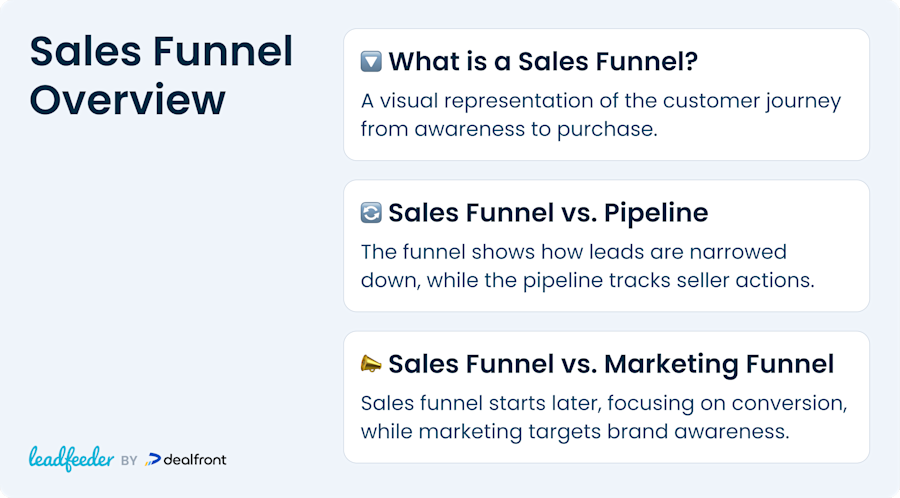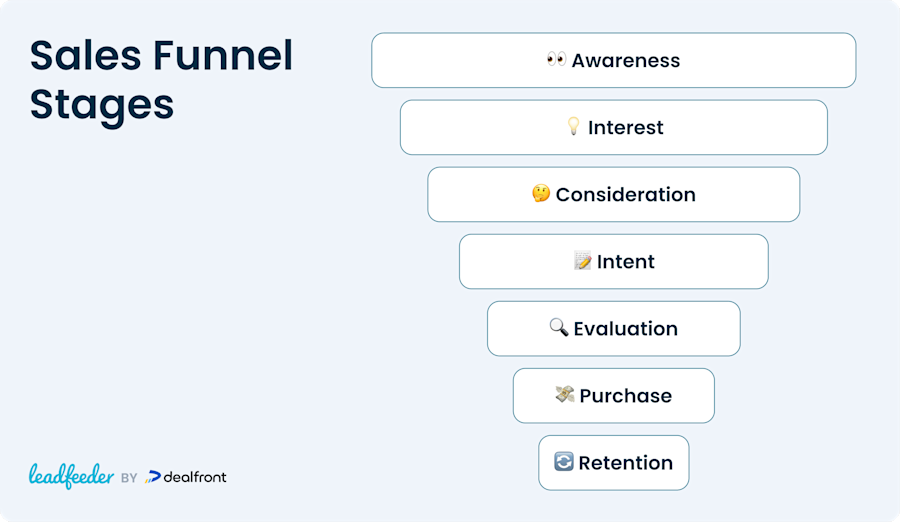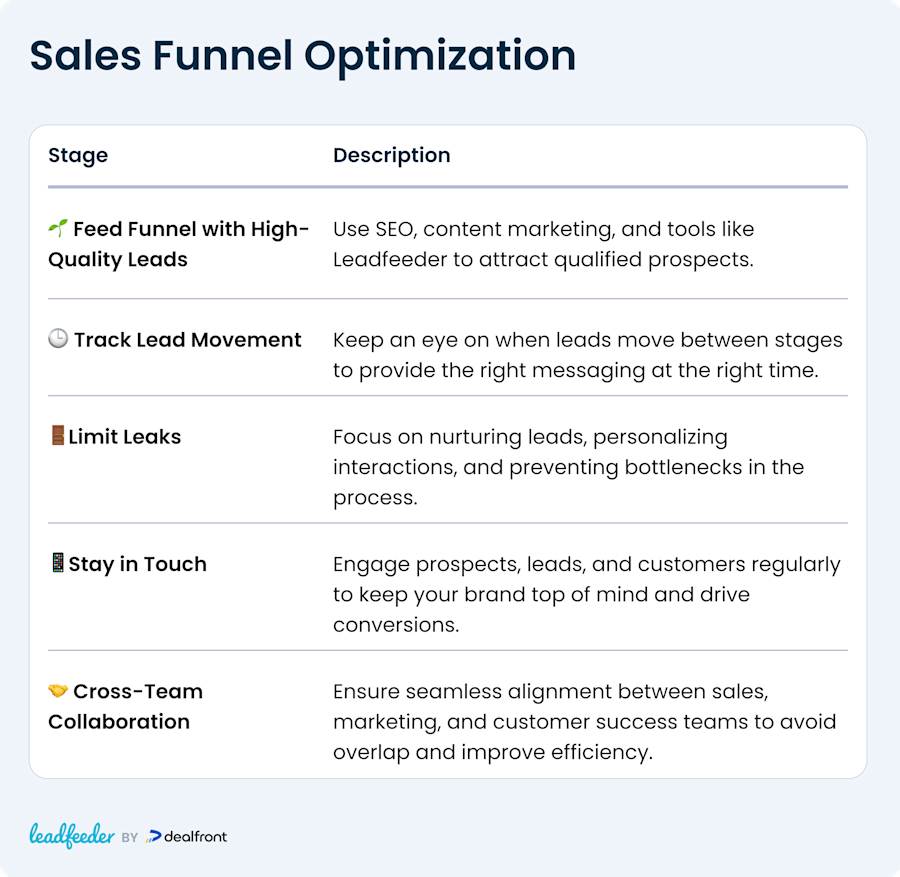Sales reps have plenty of challenges to face. In fact, 54% of salespeople say that selling got harder in 2024. An effective sales funnel will guide customers toward conversion and deliver valuable insights at every stage, making life just a little bit easier for your hardworking sales teams.
So, what are sales funnels, and how do they work? In this post, we’ll tell you everything you need to know, including how to create a sales funnel and how to optimize it for success.
What is a sales funnel?
A sales funnel is a visual representation of the journey made by potential customers as they travel from awareness of your brand to eventual purchase. It involves several distinct stages that prospects move through during the buying process.
Companies often use a sales funnel program to automate, monitor, and optimize this journey.
The funnel is depicted as a container that’s wide at the top and narrow at the bottom because you’re starting out with hundreds or thousands of potential customers and working to funnel sales leads down to a smaller group that will actually make a purchase.
As a sales development representative, your task is to guide prospects ever closer to the bottom of the funnel, using content and personalized interactions to show them the value of your product or service.
Sales funnel vs sales pipeline
People sometimes confuse the sales funnel with the sales pipeline, since both are representations of progress from prospect to paying customer. But the way they depict the journey is different.
The sales funnel’s shape shows how multiple leads are narrowed down to a small group, whereas a pipeline looks more like a flat timeline. Plus, the funnel considers the buyer’s point of view, while the pipeline focuses on the seller’s actions.
Sales funnel vs marketing funnel
The difference between marketing and sales funnels is harder to spot because there’s an overlap between each funnel—sales begins later, while the marketing funnel is focused mainly on brand awareness and drawing prospects toward your offering. As a result, the marketing funnel starts earlier.
However, the marketing and sales funnels will overlap during the awareness stage, which we’ll come to in a moment. After this, the rest of the sales funnel is designed to guide prospects toward a purchase decision.

The sales funnel stages
All sales funnels have the same basic structure, but the number of stages—and what they’re called—tends to vary between companies and teams. Some sales funnels may only include four stages, while others use six. We’ve created a seven-step sales funnel example to give you a more granular breakdown of the buyer’s journey.
Awareness
At this stage, people are becoming aware of your brand or product for the first time. It’s usually because they’ve seen your ads on social media, noticed your website in the search engine results pages (SERPs), or heard about you via word of mouth.
In many cases, they want to solve a problem or pain point, and now, they know that you offer a possible solution.
1. Interest
Once you’ve piqued their interest, the prospects will want to know more about your company as well as your products and services. They’ll be browsing your website and reading your blog articles, so it’s important to provide engaging, educational content that isn’t sales-focused. This stage is all about maintaining that initial spark of interest.
2. Consideration
At this stage, prospects know a fair amount about who you are and what you do. They’re nowhere near conversion just yet, but they’re at least open to the idea. While they’re considering, they’ll still browse for alternative solutions—so you need to make yours stand out. Make sure they can access content that shows your expertise and answers their questions.
3. Intent
These prospects are ready to interact. When they sign up for your newsletter or give you their contact details in exchange for an eBook, they’re showing purchase intent. This gives you the opportunity to target them more specifically and even make an exploratory sales call. Reps will also ask questions at this point to check that the lead is a good fit for the solution.
4. Evaluation
Having learned all about what you offer, the lead will now research your competitors and compare your solution with theirs. They’ll be looking for comparison articles, star ratings, third-party reviews, and customer testimonials. It’s up to you to make sure there are no obstacles in the path toward purchase—offer free trials and limited-time offers to suggest urgency.
5. Purchase/conversion
This is the crucial moment when the lead decides whether or not to go ahead with the purchase. Reps need to get them over the line by reminding them of the product’s value and benefits, as well as addressing any last concerns. Make sure the payment and onboarding processes are smooth.
A few leads will decide not to go ahead at this point, but it’s not the end of the road. If their situation changes, they may find their way back to you. So use smart marketing strategies to keep your brand top of mind and re-engage if they revisit your website.
6. Retention
A successful conversion isn’t the end of the road, either. Once a customer reaches the bottom of the funnel, you want to keep them there. This is where your retention strategy comes into play—keep up communication and show customers that you value them. It’s particularly important in B2B, where repeat custom is a key part of the business model.

Sales funnel examples
You can use sales funnels for both B2B and B2C sales, but there are subtle differences between the two due to the different types of buyers being targeted. Here are two examples of sales funnels in action:
B2C sales funnel example
In B2C, you’re targeting individual prospects who are solely responsible for making the purchase decision. The sales cycle is shorter, and your content needs to speak to personal preferences and immediate benefits. Short, visually appealing content is important for grabbing their attention.
Let’s say your company sells apparel. You create vibrant, eye-catching ads and run them on Facebook, where they pop up in your prospect’s feed on several occasions. This sparks their interest and they click through to your landing page, which explains the basics of your offering and invites visitors to sign up for the mailing list in return for a discount.
The visitor might do a little more research by browsing your website first, but they do decide to sign up. You can now send them not just the discount coupon but also emails about your product range, using videos and bite-sized content.
If the lead likes what they see, they’ll make a purchase and redeem the coupon. Begin the retention stage by sending a customer satisfaction survey, recommending complementary items, or inviting them to write a review.
B2B sales funnel example
The B2B sales cycle is a lot longer and typically involves multiple decision-makers within a business. Prospects will want to see detailed content that proves your expertise and shows how the solution will be profitable for their company. This could include live product demonstrations and meetings, whitepapers, webinars, and case studies.
Imagine you’re a SaaS (software as a service) company selling an accounting system. A prospect has been tasked with finding new accounting software for their organization and is searching Google when, thanks to your SEO efforts, your solution appears at the top of the SERPs.
The prospect follows the link to your landing page, which concisely explains what the product can do for them. They don’t fill out the sign-up form right away as they want to have a look at the rest of your website first. They read your content and discover that you’re well-known in the industry.
After a few visits, they sign up to download a whitepaper. You send them a series of emails with educational content before the sales reps reach out and offer a personal walk-through of the product. This prompts the lead to agree to a free trial.
The lead has to discuss your solution with others in their company, so you go back and forth, answering additional questions and finding the best package for their needs.
Eventually, they become a paying customer. You follow up regularly to build the relationship, sending content that will benefit their business. After a year, they upgrade to the higher pricing tier.
The benefits of a robust sales funnel strategy
So, how does building and using a sales funnel benefit your business? Here are the main advantages:
Boosts efficiency: One advantage of using a sales funnel is that it provides an organized and standardized approach to sales. The clearly defined stages help you to guide potential customers along their journey—and keep track of where they are.
Tightens focus: The sales funnel model sees prospects pass through a series of steps on their way to conversion, and only those with genuine purchase intent will make it into the lower stages. Unqualified prospects drop off along the way, meaning you can focus your efforts on high-quality leads.
Delivers insights: The different funnel stages show you what prospects are thinking and what they need from you during their journey. Once you understand that, you can make sure your messaging and other sales activities are relevant for each stage.
Allows optimization: The sales funnel also helps you see if your sales process is working effectively. If prospects aren’t filtering through to the later stages, you can work out where the obstacles are and make adjustments. Optimization also ensures that you maximize your resources.
Increases collaboration: Sales funnels encourage collaboration between the marketing and sales teams, especially in the awareness and interest stages. Sharing customer information and feedback gained from the sales funnel with marketing teams helps to further optimize your processes.
Improves customer experience: As well as streamlining the process for salespeople, the sales funnel benefits prospects and customers. Sales activities are tailored to their needs at each stage, including post-purchase. Personalized and consistent outreach makes them feel valued.
Fosters loyalty: Following on from the previous point, customers who feel nurtured and valued are more likely to stay loyal to the brand. If your sales funnel is effective, you’ll not only acquire long-term customers but also inspire them to refer others.
Creating a sales funnel: Five steps to build one for your business
As we said, sales funnels vary between companies. Despite this, there are certain steps every marketing sales funnel needs. Here’s how to build a sales funnel:
1. Develop ICPs and buyer personas
The first step is to define your target audience or the people who you aim to attract to the top of your funnel. Although the awareness stage naturally covers a large group of prospects, it makes sense to grab the attention of those who are most likely to convert in the long run.
You can do this by developing ideal customer profiles (ICPs). These are detailed descriptions of the type of person or company that would be a perfect fit for your offering.
Start by looking at data from your existing high-value customers, and identify the characteristics and pain points they share. Then do market research into wider trends. This will tell you what type of prospects you should target and how best to do it.
You’ll also need to create buyer personas, which are fictional profiles of your ideal customers. Give each one a name or job title, and add information such as their demographics, motivations, challenges, and preferences. Then you can segment real customers according to these personas.
2. Grab your lead’s attention
Now that you know who you want to target, you can create messaging that resonates with the right people. In the awareness stage, prospects will be looking at a lot of different websites and brands, so it’s vital to capture their attention quickly.
Visual content, such as infographics and video marketing, works well alongside paid ads that pop up on search engines or social media. You’ll also need an engaging landing page to deepen their interest when they click through from wherever they found you.
Landing pages must be visually appealing and clearly communicate what you have to offer and why it’s worth having. Prospects want to see at a glance that you have a solution for them. You’ll need an enticing CTA, inviting them to sign up for your newsletter, request a demo, or receive a discount.
Always include a sign-up form so that you can capture the visitor’s details and use them for ongoing marketing. Email drip campaigns are an ideal next step, as you can send out various types of content and promotions tailored to each funnel stage.
3. Provide value
Now that you have your prospect on the hook, you need to provide value to keep them engaged. You might use lead magnets, such as an eBook, a report, or a whitepaper, allowing prospects to download these in return for giving you their email address.
You’ll also need to fill your website with high-quality content in various forms, presenting your company as an expert in your industry or niche. You can deliver further value with content that addresses common pain points and how your solution can solve them.
This tells potential customers that you care about their needs. How-to guides, product explainer videos, demos, and free trials are all valuable for prospects who are just getting to know you. Check out what your competitors are providing, and make sure your content is better.
It’s also important to provide a smooth user experience on your website and landing pages so that they get value from every visit and see you as a professional organization.
4. Nurture your lead
You’ve successfully turned a bunch of prospects into leads, and now it’s time to guide them toward becoming paying customers. This requires careful nurturing, and in the case of B2B sales, you’ll need to do this over a longer period of time.
The idea is to keep providing useful information—personalizing the messaging wherever possible and ramping up your interactions to build a relationship with each lead. Engaging content, such as webinars and case studies, is helpful at this stage as are promotional offers.
Most nurturing strategies involve an email drip campaign, which you can do with sales funnel automation. Set up a series of emails with educational and entertaining content that you can send out at regular intervals. Include personalized offers and reminders as they get closer to a purchase decision.
If a lead isn’t ready to convert yet, you can also use social media ads and retargeting to help keep your brand top-of-mind. It’s important to align marketing and sales so that you don’t bombard these leads with emails or ads or come across as pushy.
5. Close and keep building your relationship
Congratulations! A lead has decided to go ahead with the purchase. Close the deal with great care, making sure they’re happy with the price and the package. Remember, you’re still only at the start of your relationship, and you don’t want this to be a one-off sale.
Now, that you know how to make a sales funnel and you’ve reaped the rewards, it’s all about building on the foundations. So, keep the communication going. Thank them for their purchase, check if they need any extra help using the product, and solicit feedback. Continue to send informative content, plus incentives (such as special offers) to buy again or resubscribe.
By keeping in touch, you can identify any future needs the customer might have and figure out the best ways to upsell or cross-sell to them. Loyalty programs are a great way to retain customers and continue to provide value.
For leads who didn’t make a purchase, check in with them every few months. It’s also helpful to get feedback on why they didn’t convert.
Sales funnel management: How to optimize your sales funnel process
When you understand what prospects need at different stages in a sales funnel, you should see success. But here are a few tips for managing and optimizing the process.

Feed your funnel with high-quality leads
It’s definitely worth going for high-quality leads from the get-go, as it makes your job easier in the long run. You’ll know that you’re focusing your efforts on the right people, and you should see more conversions because qualified leads are a good fit.
But how do you find these leads? Well, you can draw them in through smart use of SEO and content marketing and by basing your messaging on ICPs and data from current high-value customers. However, it also helps to use lead generation software for the lead-capture process.
For example, Leadfeeder analyzes your website traffic and identifies people who are already engaging with your campaigns. B2B sales reps can then access contact details for company decision-makers and target them with relevant messaging.
You can also reveal high-quality leads by using a lead scoring model to check if someone’s a match for your customer profile. Higher scores indicate leads who are most likely to convert, so you can prioritize them.
Understand when leads move from one stage to the next
As we’ve already mentioned, operating a successful sales funnel requires a deep understanding of your potential customers and their needs and motivations. It’s super important to be aware of when they move between funnel stages because they need different treatment at each stage.
In an automated sales funnel, you can easily keep track of where your leads are at any time and make sure you provide exactly what they need.
For example, website data will show when someone’s viewing your product comparison articles, so you know they’re in the evaluation stage. You could then invite them to chat about the superior qualities of your offering.
Work to limit leaks
A leaky sales funnel is ineffective. Sure, you always expect a few prospects to drop out along the way, but it’s worth paying attention to how and where this happens and taking action to patch up any obvious holes. That way, you can hang on to your high-quality leads.
You can avoid leaks through careful nurturing, using personalization, and providing value in every interaction. Look out for bottlenecks in the sales process, and make sure you don’t lose track when someone moves into a new funnel stage. Send regular reminders about your product and its benefits.
It’s also important to recognize that “no” sometimes just means “not now.” Don’t dismiss leads who turn you down—work to keep them in the funnel. You could create an automated email series that directly addresses their objection.
Stay in touch
We can’t overstate just how crucial it is to stay in touch with prospects, leads, and customers all the way through their journey. Apart from sending regular emails as part of a drip campaign, you can use SMS and push notifications to keep them thinking about your brand.
You’ll need to respond quickly to any inquiries from potential customers, including via social media. When someone expresses interest, follow up with them as quickly as possible.
You can also send automated messages triggered by certain actions, such as filling in a form or viewing the pricing page. This gives you more time for personal interactions with hot leads. And every interaction delivers more insights into prospects’ preferences and needs.
Encourage cross-team collaboration
You can make the sales funnel more effective by fostering close alignment between your sales reps and marketers—plus your customer success team, if you have a separate one. Teams should be sharing information rather than working in silos or competing against each other.
The right solution helps here, such as a CRM that’s integrated with your lead gen tools. With a centralized system, all teams can access the same data about customers and leads.
This also promotes greater efficiency. There’s no duplication of tasks, so you won’t get two people contacting the same lead and coming over as pushy. And there’ll be seamless hand-offs from marketing to sales and from sales to customer success for the post-purchase phase.
It’s worth noting that sales professionals at companies with aligned sales and marketing teams are 103% more likely to beat their goals than those at companies without this alignment.
Continually monitor and optimize
It should be clear by now that a sales funnel isn’t something you can set and forget. You’ll need to evaluate your results and processes continuously to find ways to improve. Customer preferences and behaviors are always changing, so it’s also a good idea to regularly update ICPs and buyer personas.
Analyze your customer and lead data, and monitor their feedback. Use customer journey analytics to track how users are moving through your funnel and identify any barriers. It’s useful to run A/B testing on your landing pages, ads, and email messages to find which ones are most successful.
Sales funnel metrics to help you track and improve performance
We’ve just told you to monitor and optimize, but how do you measure success in a sales funnel? Here are the key metrics to track:
Conversion rate: The most important metric of all is the percentage of leads that convert after moving through your sales funnel. This metric shows how effective you are at turning prospects into paying customers. To find your conversion rate, divide the total number of conversions by the total number of leads and multiply by 100.
Entrances: This is the number of leads that enter your funnel during a specific time period. By comparing time periods, you can find out if you’re attracting more or fewer leads. You can calculate it per channel or per campaign.
Flow rate: This is the average amount of time leads spend in each stage of the funnel. It can differ between B2C and B2B, but ideally, you’ll move leads on quickly.
Lead qualification rate: This is the number of qualified leads divided by the total number of leads multiplied by 100. This indicates whether or not you’re attracting the right prospects.
Average order value: This is the average amount of money spent on an individual sale per customer, showing how much revenue, on average, is generated with each purchase.
Customer lifetime value: This is the amount someone is likely to spend during the length of their relationship with your brand. By predicting how much each customer is actually worth, you can focus on high-value accounts. Calculate it by dividing the total revenue from a customer by the number of years they remain with you.
Free trials: Measure the number of leads who sign up for a free trial and the number of those who convert into paying customers. This shows you the effectiveness of the trial itself and your efforts to promote it.
Closed/lost ratio: This is the ratio of deals closed compared to deals lost. If you’re losing too many deals, you can look at different ways to get leads over the line.
Time to close: This is the average time taken to close a deal, which is a measure of your efficiency.
Retention rate: This is particularly important for B2B as it shows how many existing customers stay with your business over a period of time. It can tell you if your post-sale process is up to scratch.
Customer churn rate: This is the other side of the retention coin. It measures the number of customers lost during a given period.
Total revenue: This is the total amount of money generated by all sales in a given period. It speaks to the overall effectiveness of your sales funnel.
Feed your sales funnel high-quality leads with Leadfeeder’s help
An effective sales funnel provides an organized approach to selling. It helps you keep track of potential customers, understand what they need at each stage, and provide it to them.
It’s crucial to engage your prospects as they move along—but it’s a lot easier if you can entice high-quality leads into your funnel in the first place. That’s where Leadfeeder can help: by identifying people who are demonstrating interest by looking at your website.
This happens in real time, enabling you to act quickly while your offering is fresh in the visitor’s mind. You can use custom segmentation to qualify visitors and identify buying intent, then find accurate contact information for those leads in a global database.
Leadfeeder automatically syncs visitor data with your CRM (it integrates with all major CRM and marketing automation tools), so you can easily use it to tailor your ongoing messaging and keep prospects engaged.
Now that you're here
Leadfeeder is a tool that shows you companies that visit your website. Leadfeeder generates new leads, offers insight on your customers and can help you increase your marketing ROI.
If you liked this blog post, you'll probably love Leadfeeder, too.
Sign up




